 RUSSIA: FROM MONGOL RULE TO EMPIRE
RUSSIA: FROM MONGOL RULE TO EMPIRE
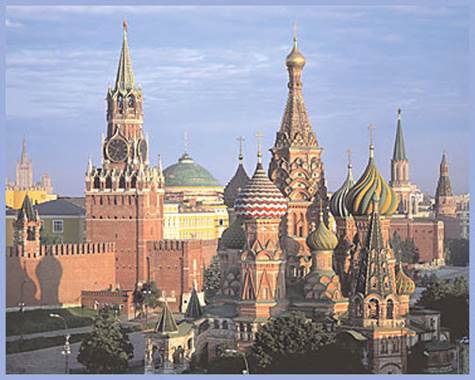
St.
Basil's Cathedral on Moscow's Red Square
Unit
Overview
In
early times, clans of Slavs migrated from Asia and settled in small villages
along the Dnieper, Volga and Don Rivers.
The Vikings also established a presence there and blended with the
Slavic peoples. A thriving trade developed between the Byzantine Empire and what
became known as the Russians. Unified by
the Mongols, the Russians drove out their conquerors and laid the foundation of
a great empire. Let’s see how it all
happened.
Russia
and Its Geography
Traditionally,
the Ural Mountains have marked the
dividing line between Europe and Asia.
Worn down by glaciers, these mountains did not prevent the Russians from
building an empire that stretched from Europe to the borders of China. Their territory included three distinct
climates, and each one contained different but valuable resources that the
others did not possess. The northern
regions were covered with forests which provided lumber for construction and
fuel. The forests also were home to
fur-bearing animals, such as foxes, wolves and beavers whose hides were prized
by trappers and hunters. Farmers settled
in the area around the modern nation of Ukraine. Here, warmer temperatures and fertile fields
with good soil produced wheat, oats and other grains that were difficult to
grow in the north. Further to the south,
a grassy plain or steppe offered
pasture for cattle and horses. These
three climates zones were connected by a network of rivers that transported
people and products. The Dnieper River and Europe’s longest
river, the Volga, turned into
important trade routes.
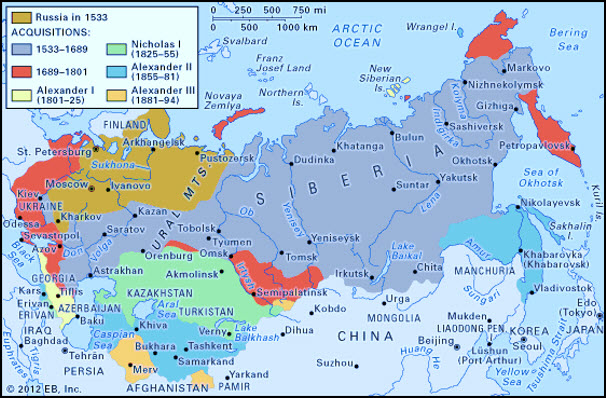
Map Showing the Expansion of the Russian
Empire
The
Slavs and the Vikings
While
the Romans still ruled Western Europe, clans of Slavs, who migrated from Asia, arrived in Eastern Europe. One group moved northward and built small
villages along the rivers. The access to
water routes encouraged these Slavs, who eventually became known as the Russians, to trade with one another. By the 700s, the Vikings or the Varangians,
as the Slavs called them, had begun to sail their long ships on the rivers
bordering the Slavic villages. They
traded with the Slavs and agreed not to destroy their towns as long as they
received the required tribute. The
Vikings built forts along the rivers and settled with the Slavic people. Their ships carried lumber, honey, animal hides
and wax on the water routes to Constantinople,
the rich capital of the Byzantine Empire. The Russians gained wealth through trade and
built the city of Kiev, which became
the base for their thriving trade network.
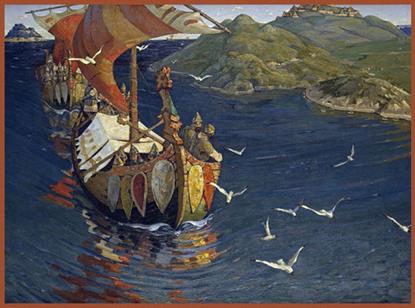
Artist's Rendition of a Viking Ship on a Russian River
Missionaries
arrived from Constantinople to convert the Russians to Christianity. They translated the Bible into Slavic
language by adapting the Greek alphabet into the Cyrillic alphabet. This
became the foundation for the written form of the Russian language and is still
used today. As the number of Byzantine
Christians increased, the Russians began to create their own religious art from
the Byzantine style. For example,
Russian churches were often designed to include the onion-shaped domes that
were popular in Constantinople. The
Christian church in Russia became known as the Russian Orthodox Church.
Russian leaders controlled the church just as the Byzantine emperors had
done.
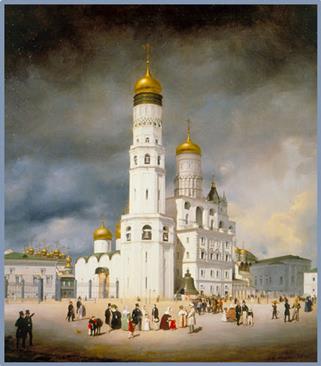
Gold Onion Domes on the Bell Tower of Ivan the Great
The
Mongol Invasion
As
the Byzantine Empire struggled to survive, trade declined, and this negatively
impacted the once prosperous city of Kiev.
At the same time, Russian princes, motivated by jealousy and greed,
argued bitterly among themselves. This
left the city unprepared to face the Mongol invaders when they arrived in
1236. The Golden Horde, a Mongol force named for the color of its tents, was
led by a grandson of Genghis Khan. These
warriors completely destroyed Kiev and carried off its treasures. By 1241, the Mongols controlled all of Russia
and continued to do so for over two hundred years.
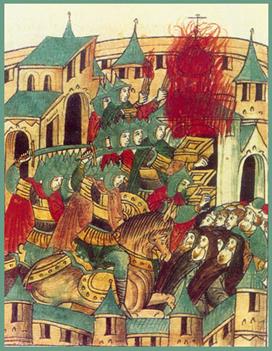
Mongols Raiding a Russian Village in
1238
Although
the Mongols could be ruthless, they were mostly interested in collecting
tributes from the people whom they had conquered. As long as the required payments were made on
time, Russian princes were generally permitted to rule as they pleased. The
Mongols, who were Muslims, also allowed Russian Orthodox Christians to practice
their faith. However, they did force
what had been a group of small, independent kingdoms to live under one
rule. This was the beginning of a united
Russia. Mongol leadership resulted in a period of
relative peace, but, at the same time, it isolated Russia from Western
Europe. This became a disadvantage
because the West was making rapid advancements in science and technology.
Moscow’s
Rise to Power
Following
the Mongol conquest, the princes of Moscow,
a small town in the northern forests, worked steadily to increase their
authority. Located near the headwaters
of the Don, Dnieper and Volga Rivers, the city was in perfect position to
control the travel and trade of European Russia. Moscow began its rise to power under the
leadership of Ivan I, a Russian
prince who served as a tax collector for the Mongols. They appreciated his efficiency and did not
object when he added several small states near Moscow to his kingdom. In 1328, the leader of the Russian Orthodox
Church announced that he was moving his headquarters to Moscow. This made the city a religious as well as a
political center. When the Mongol Empire
weakened, Moscow seized its opportunity and refused to pay the annual tribute
to the Mongols. This led to the Battle Kulikovo in which Prince Dimitri Donskoy of Moscow and
his Russian forces defeated the Golden Horde in 1380. Although the Mongols continued to raid
Russian territory, this victory was considered the turning point in the quest
to end their rule of Russia.
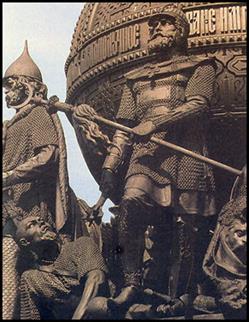
Statue of Prince Dimitri
Ivan
the Great and Ivan the Terrible
Much
of Moscow’s continued success resulted from the efforts of Ivan III or Ivan the Great. During his forty-three year reign, Ivan III
tripled the size of the kingdom by putting almost all of northern Russia within
his realm. Under his leadership, Russia
became an empire. Using the
double-headed eagle as his symbol, Ivan III gave himself the title of czar from the Russian word for
Caesar. Determined to be an absolute
ruler, he refused to share power with the boyars
or large landowners. Because he wanted
his capital to be impressive, Ivan took on a number of building projects. The Kremlin,
an ancient fort in the center of Moscow, was rebuilt with massive walls that
were fifteen feet thick. Three new
churches were commissioned, and a new palace was designed for the czar and his
family. When he died in 1505, Ivan ruled
a united Russian nation with no legal restrictions on his authority. This set a precedent for future Russian
leaders.
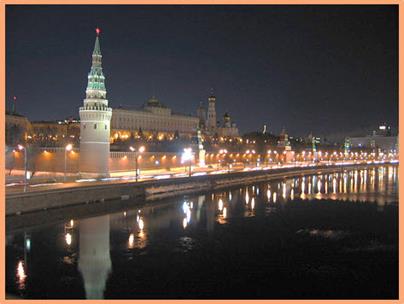
Towers and Walls of the Kremlin: Moscow, Russia
After
the death of Ivan III, his son Vasili
became the next ruler of Russia, but his reign was brief. Ivan
IV, grandson of Ivan the Great, was next in line for the throne, but he was
only three years old. The boyars saw
this as an opportunity to limit the czar’s power and plotted against the young
boy. In fact, there is some evidence
that his mother was poisoned while trying to protect him. Ivan survived his boyhood, but he viewed the
boyars with suspicion and mistrust for the rest of his life. For a few years, Ivan IV ruled successfully. He led armies that turned back the Mongol
raiders, established a fair legal code and made an effort to increase trade
with Europe.
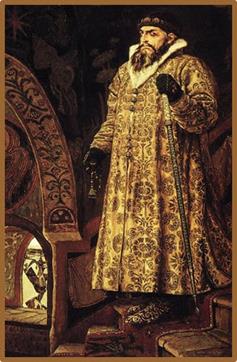
Portrait of Ivan IV
Following
the death of his wife, however, Ivan IV
became increasingly unstable. His
distrust of the boyars turned to violent rage.
The czar organized his own agents to terrorize anyone whom he suspected
of being disloyal. The ways in which he
misused his authority earned him the name Ivan
the Terrible. Because Ivan IV had
killed his son and heir to the throne, the years following his death brought
chaos to Russia. Disagreements over
succession, foreign invasions and peasant uprising resulted in a period of
Russian history remembered as the Time
of Troubles.
At
last, a group of church leaders and nobles met and named Michael Romanov as the new czar.
This established the Romanov
Dynasty which ruled Russia until 1917.
Under the Romanov leadership, the Russians continued to expand their
empire and developed as a world power.
While the citizens of Western Europe began to demand limitations on the
authority of their rulers, the czars governed as autocrats or individuals with total control over government and
society. While Europe entered the
Industrial Age, Russia remained an agricultural economy, and millions of
peasants were still tied to the land.
These factors shaped the course of Russian history and the country’s
interaction with the rest of the world.
What
Happened Next?
For
centuries, Muslim and Italian merchants controlled the exchange of goods
between Asia and Europe. By the 1400s,
however, European nations recognized the advantages of discovering their own
trade routes. Improvements in technology
and better maps inspired exploration and the world’s First Global Age. Before moving on to these topics in the next
unit, review the names and terms listed in the word bank below; then, complete
Questions 21 through 30.